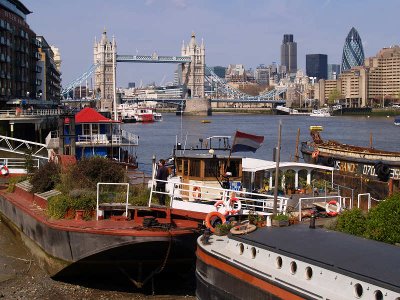These iconic buildings seem to be represented by the same group of photographs all the time, and as a consequence, when we see the buildings for ourselves, we are often taken aback by them. Sometimes they appear smaller, often more mundane, and frequently the context surprises us. Almost always we get actual views that don't correspond to our preconceptions - glimpses down streets, the back of the building, or the foot of it as it towers over us. This experience should help us to realise that famous buildings (like famous people) are often well-known through familiarity rather than because of any exceptional qualities that they might possess. It's true that some of the buildings listed above are great architecture, but some of them are not. The building in my photograph above is one of the latter.
Tower Bridge is a large, bascule bridge, designed by Horace Jones and opened in 1894. One suspects that if its towers weren't so large and ornately Gothicised then it would not have iconic status. As a piece of architecture it's nothing special: as a London landmark it achieves world-wide recognition. Most photographs have the bridge filling the frame in a diagonal view from the north or south bank of the Thames, either in sunlight or floodlit at night. I've taken such shots myself. However, when I saw Tower Bridge from this point on the south bank I knew I had to capture it with my camera. The shot shows the bridge, not as an icon, but as a functional crossing of a bustling river. The busy foreground of barges, and the buildings of the City make the building less dominant, not as eye-catching: in fact, less iconic!
Quiz answers: 1 New York, 2 Paris, 3 Rome, 4 Athens, 5 Berlin, 6 Madrid, 7 Barcelona, 8 Washington, 9 Cairo, 10 Jerusalem.
photograph & text (c) T. Boughen
